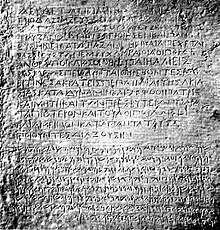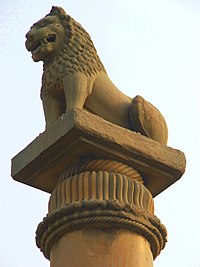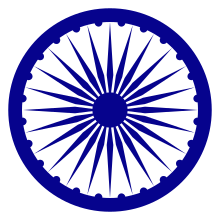Ashoka (Devanāgarī: अशोक, IAST: Aśoka, IPA: [aˈɕoːkə], ca. 304–232 BC), also known as Ashoka the Great, was an Indian emperor of theMaurya Dynasty who ruled almost all of the Indian subcontinent from ca. 269 BC to 232 BC.[1] One of India's greatest emperors, Ashoka reigned over most of present-day India after a number of military conquests. His empire stretched from present-day Pakistan and Afghanistanin the west, to the present-day Bangladesh and the Indian state of Assam in the east, and as far south as northern Kerala and Andhra Pradesh. He conquered the kingdom named Kalinga, which none of his ancestors had conquered starting from Chandragupta Maurya. His reign was headquartered in Magadha (present-day Bihar). He embraced Buddhism after witnessing the mass deaths of the Kalinga War, which he himself had waged out of a desire for conquest. He was later dedicated to the propagation of Buddhism across Asia and established monuments marking several significant sites in the life of Gautama Buddha. Ashoka was a devotee of ahimsa (nonviolence), love,truth, tolerance and vegetarianism. Ashoka is remembered in history as a philanthropic administrator. In the history of India, Ashoka is referred to as Samraat Chakravartin Ashoka – the "Emperor of Emperors Ashoka".
| A "Chakravartin" ruler, first century BC/CE. Andhra Pradesh, Amaravati. Preserved at Musee Guimet | |
| Reign | 274–232 BC |
|---|---|
| Coronation | 270 BC |
| Titles | Samraat Chakravartin; other titles include Devanampriyaand Priyadarsin |
| Born | 304 BC |
| Birthplace | Pataliputra, Patna |
| Died | 232 BC (aged 72) |
| Place of death | Pataliputra, Patna |
| Buried | Ashes immersed in theGanges River, possibly atVaranasi, Cremated 232 BC, less than 24 hours after death |
| Predecessor | Bindusara |
| Successor | Dasaratha Maurya |
| Consort | Maharani Devi |
| Wives | Rani Tishyaraksha Rani Padmavati Rani Kaurwaki |
| Offspring | Mahendra, Sanghamitra, Teevala, Kunala |
| Royal House | Mauryan dynasty |
| Father | Bindusara |
| Mother | Rani Dharma or Shubhadrangi |
| Religious beliefs | Buddhism |
His name "aśoka" means "painless, without sorrow" in Sanskrit (the a privativum and śoka "pain, distress"). In his edicts, he is referred to asDevānāmpriya (Pali Devānaṃpiya or "The Beloved Of The Gods"), and Priyadarśin (Pali Piyadasī or "He who regards everyone with affection").
Ashoka played a critical role in helping make Buddhism a world religion.[2] As the peace-loving ruler of one of the world's largest, richest and most powerful multi-ethnic states, he is considered an exemplary ruler, who tried to put into practice a secular state ethic of non-violence. The emblem of the modern Republic of India is an adaptation of the Lion Capital of Ashoka.
The Divyavandana talks of Ashoka putting down a revolt due to activities of wicked ministers. This may have been an incident inBindusara's times. Taranatha's account states that Chanakya, one of Bindusara's great lords, destroyed the nobles and kings of 16 towns and made himself the master of all territory between the eastern and the western seas. Some historians consider this as an indication of Bindusara's conquest of the Deccan while others consider it as suppression of a revolt. Following this, Ashoka was stationed at Ujjayini as governor.[5]
Bindusara's death in 273 BC led to a war over succession. According to Divyavandana, Bindusara wanted his son Sushim to succeed him but Ashoka was supported by his father's ministers. A minister named Radhagupta seems to have played an important role. Ashoka managed to become the king by getting rid of the legitimate heir to the throne, by tricking him into entering a pit filled with live coals. The Dipavansa and Mahavansa refer to Ashoka killing 99 of his brothers, sparing only one, named Tissa,[5] although there is no clear proof about this incident. The coronation happened in 269 BC, four years after his succession to the throne.
Ashoka is said to have been of a wicked nature and bad temper. He submitted his ministers to a test of loyalty and had 500 of them killed. He also kept a harem of around 500 women. When a few of these women insulted him, he had the whole lot of them burnt to death. He also built hell on earth, an elaborate and horrific torture chamber. This torture chamber earned him the name of Chand Ashoka (Sanskrit), meaning Ashoka the Fierce.[5]
Ascending the throne, Ashoka expanded his empire over the next eight years, from the present-day boundaries and regions of Burma–Bangladesh and the state of Assam in India in the east to the territory of present-day Iran / Persia and Afghanistan in the west; from the Pamir Knots in the north almost to the peninsular of southern India (i.e. Tamil Nadu / Andhra Pradesh).[5]
While the early part of Ashoka's reign was apparently quite bloodthirsty, he became a follower of the Buddha's teaching after his conquest of Kalinga on the east coast of India in the present-day states of Orissa and North Coastal Andhra Pradesh. Kalinga was a state that prided itself on its sovereignty and democracy. With its monarchical parliamentary democracy it was quite an exception in ancient Bharata where there existed the concept of Rajdharma. Rajdharma means the duty of the rulers, which was intrinsically entwined with the concept of bravery and Kshatriya dharma. The Kalinga War happened eight years after his coronation. From his 13th inscription, we come to know that the battle was a massive one and caused the deaths of more than 100,000 soldiers and many civilians who rose up in defense; over 150,000 were deported.[7] When he was walking through the grounds of Kalinga after his conquest, rejoicing in his victory, he was moved by the number of bodies strewn there and the wails of the kith and kin of the dead.
The brutality of the conquest led him to adopt Buddhism, and he used his position to propagate the relatively new religion to new heights, as far as ancient Rome and Egypt. He made Buddhism his state religion around 260 BC, and propagated it and preached it within his domain and worldwide from about 250 BC. Emperor Ashoka undoubtedly has to be credited with the first serious attempt to develop a Buddhist policy.
Prominent in this cause were his son Venerable Mahindra and daughter Sanghamitra (whose name means "friend of the Sangha"), who established Buddhism in Ceylon (now Sri Lanka). He built thousands of Stupas and Viharas for Buddhist followers. The Stupas of Sanchi are world famous and the stupa namedSanchi Stupa was built by Emperor Ashoka. During the remaining portion of Ashoka's reign, he pursued an official policy of nonviolence (ahimsa).
 Bilingual inscription in (Greek andAramaic) by king Ashoka, from Kandahar(Shar-i-kuna). Kabul Museum.
Bilingual inscription in (Greek andAramaic) by king Ashoka, from Kandahar(Shar-i-kuna). Kabul Museum. Lion Capital of Asoka (Ashokmudra)
Main article: Lion Capital of Asoka
The Lion capital of Ashoka is a sculpture of four "Indian lions" standing back to back. It was originally placed atop the Aśoka pillar at Sarnath, now in the state of Uttar Pradesh, India. The pillar, sometimes called the Aśoka Column is still in its original location, but the Lion Capital is now in theSarnath Museum. This Lion Capital of Ashoka from Sarnath has been adopted as the National Emblem of India and the wheel "Ashoka Chakra" from its base was placed onto the center of the National Flag of India.
The capital contains four lions (Indian / Asiatic Lions), standing back to back, mounted on an abacus, with a frieze carrying sculptures in high relief of an elephant, a galloping horse, a bull, and a lion, separated by intervening spoked chariot-wheels over a bell-shaped lotus. Carved out of a single block of polished sandstone, the capital was believed to be crowned by a 'Wheel of Dharma' (Dharmachakra popularly known in India as the "Ashoka Chakra").
The Ashoka Lion capital or the Sarnath lion capital is also known as the national symbol of India. The Sarnath pillar bears one of the Edicts of Ashoka, an inscription against division within the Buddhist community, which reads, "No one shall cause division in the order of monks". The Sarnath pillar is a column surmounted by a capital, which consists of a canopy representing an inverted bell-shaped lotus flower, a short cylindrical abacus with four 24-spoked Dharma wheels with four animals (an elephant, a bull, a horse, a lion).
The four animals in the Sarnath capital are believed to symbolize different steps of Lord Buddha's life.
- The Elephant represents the Buddha's idea in reference to the dream of Queen Maya of a white elephant entering her womb.
- The Bull represents desire during the life of the Buddha as a prince.
- The Horse represents Buddha's departure from palatial life.
- The Lion represents the accomplishment of Buddha.
Besides the religious interpretations, there are some non-religious interpretations also about the symbolism of the Ashoka capital pillar at Sarnath. According to them, the four lions symbolize Ashoka's rule over the four directions, the wheels as symbols of his enlightened rule (Chakravartin) and the four animals as symbols of four adjoining territories of India.
The Lion capital of Ashoka is a sculpture of four "Indian lions" standing back to back. It was originally placed atop theAśoka pillar at Sarnath, now in the state of Uttar Pradesh, India by Emperor Ashoka circa 250 BC. The pillar, sometimes called the Aśoka Column is still in its original location, but the Lion Capital is now in the Sarnath Museum. This Lion Capital of Ashoka from Sarnath has been adopted as the National Emblem of India and the wheel "Ashoka Chakra" from its base was placed onto the center of the National Flag of India.
The capital contains four lions (Indian / Asiatic Lions), standing back to back, mounted on an abacus, with a friezecarrying sculptures in high relief of an elephant, a galloping horse, a bull, and a lion, separated by intervening spoked chariot-wheels over a bell-shaped lotus. Carved out of a single block of polished sandstone, the capital was believed to be crowned by a 'Wheel of Dharma' (Dharmachakra popularly known in India as the "Ashoka Chakra"), which has now been lost. There is a similar intact Ashoka pillar in Thailand (see photo) with a similar four lion capital intact and crowned with Ashoka Chakra / Dharmachakra.





No comments:
Post a Comment